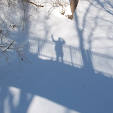The bus drives to a farm that is just a bit north of the Dairy Adventure. One of the first attractions is a group of four tanks which contain manure that is being digested by bacteria, turning it into compost and methane gas. When Mike Rowe visited the farms to film a segment for Dirty Jobs, he got to work on a tank like one of these.
Then the tour shows you how cow food is prepared. An important ingredient is silage, which I remember from my youth as being made in silos. Silage is created from chopped corn plants that are allowed to ferment in the absence of oxygen. At the Fair Oaks Dairies it is fermented in large piles or hills covered with plastic which is held down with old tires. What looks like the sand of a hill is actually cow food.
The commentary then explains how the silage is mixed with various other ingredients to produce a super nutritional diet for the cows.
By the way, there are ten dairy farms in the complex, but they are not owned by a single corporation or partnership. The ownerships arrangements are complex and I do not understand them.
Then it is time for a visit to the dry cows. These are cows waiting to have calves and are not producing milk. As the cows get closer to delivery, they move up the barn until they eventually get to the birthing area. One of Mike Rowe's episodes from the Fair Oaks farms had him helping artificially inseminate cows. They weaknesses of each cow were noted and an appropriate bull was chosen to sire her calf in an attempt to improve the herd.
Cows are able to tolerate the cold quite well. When it gets too cold and windy, a plastic barrier can be put up to cut wind and keep some of the heat in the barns. The more common problem is summer heat. Cows tolerate the cold quite well, but not the heat. To keep them comfortable on hot summer days, they are sprayed with water and fans cool them.
After the calves are born, they spend very little time with their mothers but are rather quickly sent to their own area. The males get sold (and eventually appear in the meat counter of the grocery store or in your favorite fast-food burger). The females are sent off to a bovine boarding school to grow up and eventually come back to the Fair Oaks farms to produce milk.
The calves are fed milk for a short time, but as soon as possible they are switched over to a non-milk diet. Mama has to go to work--her career comes before calf care.
The bus then drove through a barn of cows that were producing milk, which looked pretty much like the other cow barn.
Then it was time to see the milking operation. As we left the bus to go up the stairs, I could not help noticing that the bus with its mirrors looked a lot like a giant beetle.
People and cows are kept separate not to protect the people, but to protect the cows. The operators of the farm want to make sure that people from distant places do not accidentally introduce disease organisms that are new to this area. I thought this rather strange in a way because during the many years since animals were domesticated, a lot of diseases passed from our domesticated animals to humans. That was one of the reasons that when the Europeans arrived in the Americas, they had lots of diseases to introduce to the inhabitants of the Americans whereas the inhabitants of the Americas had very few to give back in return because, except for the llama and guinea pig, they had not domesticated any mammals. The story of this encounter and similar encounters in Asia, Africa, and Oceania is told in one of the best books I have read in the past decade, Jared Diamond's Guns, Germs, and Steel: The Fates of Human Societies.
From the visitor's galley you see the cow merry-go-round. The cows enter, get hooked up with a milking machine, and ride around the circuit. Most of them are ready to get off after one trip, but a few will be allowed a second circuit. The cows like it and they quickly learn the routine. They are milked three times a day and the carousal is busy around the clock. (I wonder what happens if they have a mechanical breakdown. Maybe next time I will remember to ask.)
There are several people who have to prepare the cows and attach the hoses. The cows have a collar with a transponder so they can be identified. Their milk production is measured and each cow has a computer record of her productivity. (That takes Taylorism to a whole new level.) A little video plays above the viewing window explaining exactly what is going on.
The milk is piped to a filter and then is cooled from cow body temperature, which is a bit over 100 degrees, to the low thirties. It is shipped out in insulated tankers to Indianapolis or points south or wherever the market says it should go. Each day about forty tankers with a quarter million gallons of milk leave the ten dairies of the complex. It is an impressive operation.
That ends our February Dairy Adventure. Remember, there is another free day on the 14th--Valentine's Day. If you live nearby and have never been there, take advantage of the free day. Everyone should see the Dairy Adventure.
Update: Fair Oaks Farms has just updated their website with a new design.












2 comments:
I didn't realize all that was at the Dairy Farm! I need to get there sometime...maybe when my niece and nephews visit!
I am amazed by the carousel. It is surprising how the cow knows its once around cycle is over. ja
Post a Comment